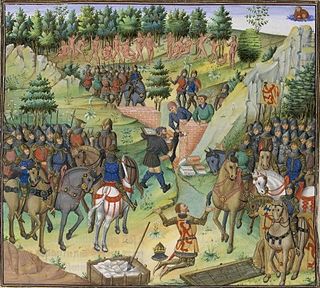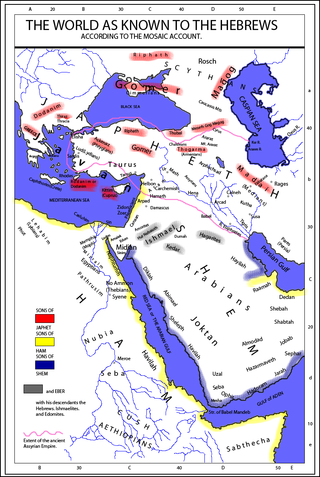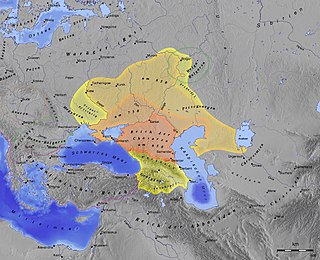
Japheth is one of the three sons of Noah in the Book of Genesis, in which he plays a role in the story of Noah's drunkenness and the curse of Ham, and subsequently in the Table of Nations as the ancestor of the peoples of the Aegean Sea, Anatolia, and elsewhere. In medieval and early modern European tradition he was considered to be the progenitor of the European peoples, while Islamic traditions also include the Chinese people among his descendants.

The Generations of Noah, also called the Table of Nations or Origines Gentium, is a genealogy of the sons of Noah, according to the Hebrew Bible, and their dispersion into many lands after the Flood, focusing on the major known societies. The term nations to describe the descendants is a standard English translation of the Hebrew word "goyim", following the c. 400 CE Latin Vulgate's "nationes", and does not have the same political connotations that the word entails today.

Ashkenazi Jews, also known as Ashkenazic Jews or Ashkenazim, constitute a Jewish diaspora population that emerged in the Holy Roman Empire around the end of the first millennium CE. They traditionally spoke Yiddish and largely migrated towards northern and eastern Europe during the late Middle Ages due to persecution. Hebrew was primarily used as a literary and sacred language until its 20th-century revival as a common language in Israel.

Gog and Magog or Yajuj and Majuj are a pair of names that appear in the Bible and the Quran, variously ascribed to individuals, tribes, or lands. In Ezekiel 38, Gog is an individual and Magog is his land. By the time of the New Testament's Revelation 20:8, Jewish tradition had long since changed Ezekiel's "Gog from Magog" into "Gog and Magog".

According to Tacitus's Germania, Tuisto is the legendary divine ancestor of the Germanic peoples. The figure remains the subject of some scholarly discussion, largely focused upon etymological connections and comparisons to figures in later Germanic mythology.
Jewish ethnic divisions refer to many distinctive communities within the world's Jewish population. Although considered a self-identifying ethnicity, there are distinct ethnic subdivisions among Jews, most of which are primarily the result of geographic branching from an originating Israelite population, mixing with local communities, and subsequent independent evolutions.
World Agudath Israel, usually known as the Aguda, was established in the early twentieth century as the political arm of Ashkenazi Torah Judaism. It succeeded Agudas Shlumei Emunei Yisroel in 1912. Its base of support was located in Eastern Europe before the Second World War but, due to the revival of the Hasidic movement, it included Orthodox Jews throughout Europe. Prior to World War II and the Holocaust, Agudath Israel operated a number of Jewish educational institutions throughout Europe. After the war, it has continued to operate such institutions in the United States as Agudath Israel of America, and in Israel. Agudath Israel is guided by its Moetzes Gedolei HaTorah in Israel and the USA.

Togarmah is a figure in the "table of nations" in Genesis 10, the list of descendants of Noah that represents the peoples known to the ancient Hebrews. Togarmah is among the descendants of Japheth and is thought to represent some people located in Anatolia. Medieval sources claimed that Togarmah was the legendary ancestor of several peoples of the Caucasus.
Gomer was the eldest son of Japheth, and father of Ashkenaz, Riphath, and Togarmah, according to the "Table of Nations" in the Hebrew Bible.

The term Japhetites refers to the descendants of Japheth, one of the three sons of Noah in the Bible. The term has been adopted in ethnological and linguistic writing from the 18th to the 20th century but has now become obsolete.
Minhag is an accepted tradition or group of traditions in Judaism. A related concept, Nusach (נוסח), refers to the traditional order and form of the prayers.
Riphath was great-grandson of Noah, grandson of Japheth, son of Gomer, younger brother of Ashkenaz, and older brother of Togarmah according to the Table of Nations in the Hebrew Bible. The name appears in some copies of 1 Chronicles as "Diphath", due to the similarities of the characters resh and dalet in the Hebrew and Aramaic alphabets.
Ashkenazi is a surname of Jewish origin. The term Ashkenaz refers to the area along the Rhine in Western Europe where diaspora Jews settled and formed communities during the Middle Ages.
Nusach Sefard, Nusach Sepharad, or Nusach Sfard is the name for various forms of the Jewish siddurim, designed to reconcile Ashkenazi customs with the kabbalistic customs of Isaac Luria. To this end it has incorporated the wording of Nusach Edot haMizrach, the prayer book of Sephardi Jews, into certain prayers. Nusach Sefard is used nearly universally by Hasidim, as well as by some other Ashkenazi Jews but has not gained significant acceptance by Sephardi Jews. Some Hasidic dynasties use their own version of the Nusach Sefard siddur, sometimes with notable divergence between different versions.
Nusach Ashkenaz is a style of Jewish liturgy conducted by Ashkenazi Jews. It is primarily a way to order and include prayers, and differs from Nusach Sefard and Baladi-rite prayer, and still more from the Sephardic rite proper, in the placement and presence of certain prayers.

Binyamin Shlomo Hamburger is a rabbi and author who is regarded as an expert on the subject of minhag Ashkenaz, the customs of German and Western European Jews, and their history. Born in Basel, Switzerland, to German parents, he currently lives in Bnei Brak, Israel.

The Khazar hypothesis of Ashkenazi ancestry, often called the Khazar myth by its critics, is a largely abandoned historical hypothesis that postulated that Ashkenazi Jews were primarily, or to a large extent, descended from Khazars, a multi-ethnic conglomerate of mostly Turkic peoples who formed a semi-nomadic khanate in and around the northern and central Caucasus and the Pontic–Caspian steppe. The hypothesis also postulated that after collapse of the Khazar empire, the Khazars fled to Eastern Europe and made up a large part of the Jews there. The hypothesis draws on medieval sources such as the Khazar Correspondence, according to which at some point in the 8th–9th centuries, a small number of Khazars were said by Judah Halevi and Abraham ibn Daud to have converted to Rabbinic Judaism. The scope of the conversion within the Khazar Khanate remains uncertain, but the evidence used to tie the subsequent Ashkenazi communities to the Khazars is meager and subject to conflicting interpretations.

The expression 'Eastern European Jewry' has two meanings. Its first meaning refers to the current political spheres of the Eastern European countries and its second meaning refers to the Jewish communities in Russia and Poland. The phrase 'Eastern European Jews' or 'Jews of the East' was established during the 20th century in the German Empire and in the western provinces of the Austro-Hungarian Empire, aiming to distinguish the integrating Jews in Central Europe from those Jews who lived in the East. This feature deals with the second meaning of the concept of Eastern European Jewry- the Jewish groups that lived in Poland, Ukraine, Belarus, Latvia, Lithuania, Estonia, Russia, Romania, Hungary and modern-day Moldova in collective settlement. Many of whom spoke Yiddish.

Since early modern times, a number of biblical ethnonyms from the Table of Nations in Genesis 10 have been used as a basis for classifying human racial and national identities. The connection between Genesis 10 and contemporary ethnic groups began during classical antiquity, when authors such as Josephus, Hippolytus and Jerome analyzed the biblical list.










